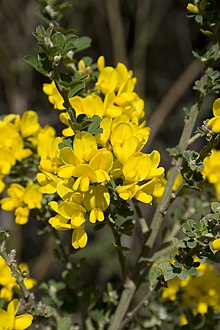Genista monspessulana
| Genista monspessulana | |
|---|---|
 |
|
| Scientific classification | |
| Kingdom: | Plantae |
| (unranked): | Angiosperms |
| (unranked): | Eudicots |
| (unranked): | Rosids |
| Order: | Fabales |
| Family: | Fabaceae |
| Genus: | Genista |
| Species: | G. monspessulana |
| Binomial name | |
|
Genista monspessulana (L.) O.Bolós & Vigo |
|
Genista monspessulana (syn. Cytisus monspessulanus or Teline monspessulana) also known as French broom, Montpellier broom and Cape broom, is a woody perennial shrub and a legume. The species is native to the Mediterranean region, and is considered an invasive plant in most places where it has been introduced.
French broom, Genista monspessulana, grows to 1–2.5 metres (3 ft 3 in–8 ft 2 in) tall, with slender green branches. The leaves are evergreen, trifoliate with three narrow obovate leaflets, 1–2 centimetres (0.39–0.79 in) long. The flowers are yellow, grouped 3-9 together in short racemes. Like other legumes, it develops its seeds within a pod. The pods are 2–3 cm long, tough and hard, and are transported easily by flowing water and animals. They burst open with force, dispersing the seeds several metres. The plant begins seed production once it reaches a height of approximately 40 centimetres (16 in), and each plant can live for 10–20 years. One mature plant can produce 10,000 seeds per season. The generous seed production and the plant's ability to re-sprout after cutting or burning help it to invade new habitat vigorously when introduced.
It is related to the common broom and Spanish broom. This suite of plants is common in European shrublands. French broom was originally distributed throughout Mediterranean Europe and northwest Africa, the Azores, and the Canary Islands. Due to its lower tolerance for frost than other broom species, it is common in warmer, lower elevation areas. It is found on coastal strips and in sunny inland areas, and does best with plentiful rainfall and sandy soils.
...
Wikipedia
